Childhood obesity in Australia
VerifiedAdded on 2023/06/11
|14
|3912
|288
AI Summary
This paper discusses the prevalence of childhood obesity in Australia, the determinants of obesity, and proposes health education and health communication strategies to address the issue.
Contribute Materials
Your contribution can guide someone’s learning journey. Share your
documents today.
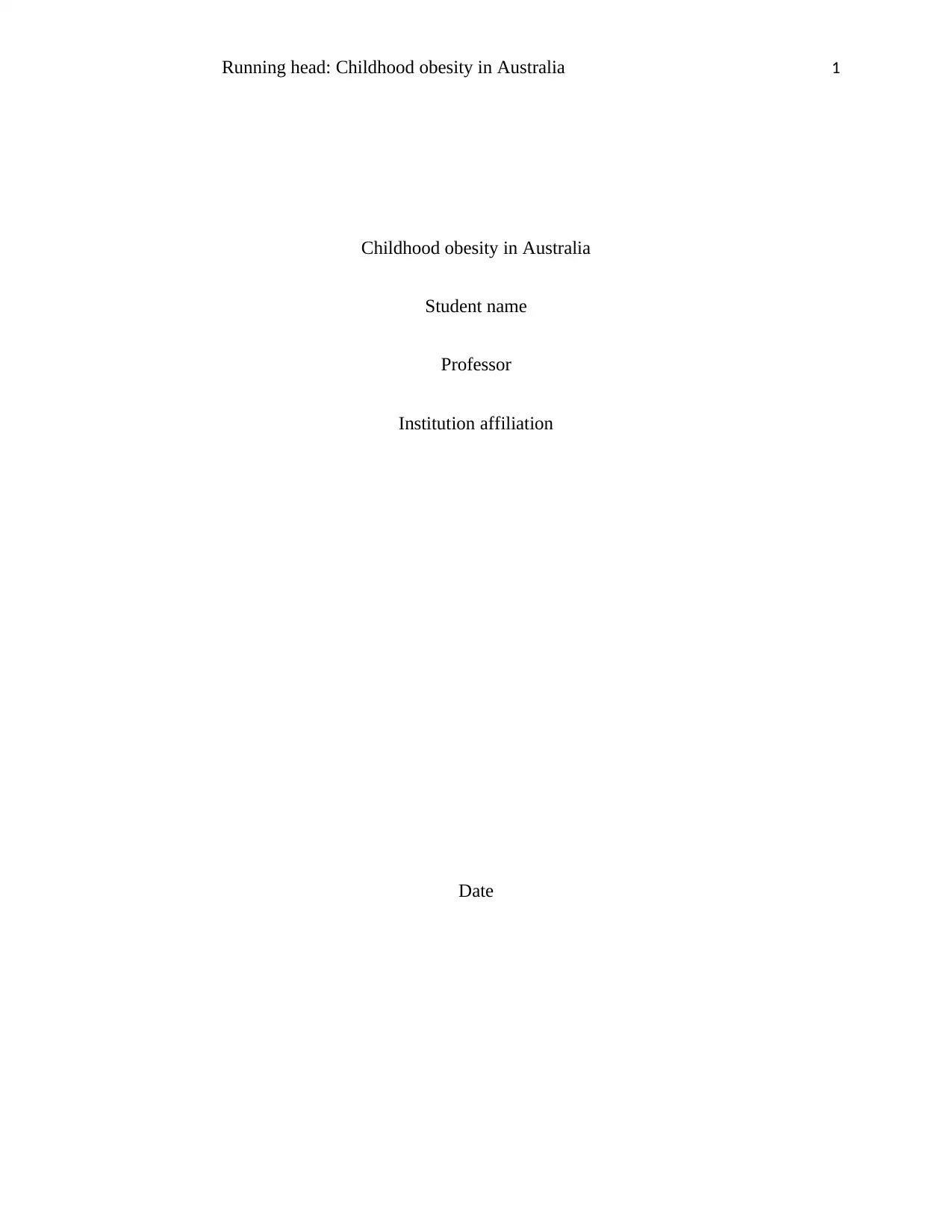
Running head: Childhood obesity in Australia 1
Childhood obesity in Australia
Student name
Professor
Institution affiliation
Date
Childhood obesity in Australia
Student name
Professor
Institution affiliation
Date
Secure Best Marks with AI Grader
Need help grading? Try our AI Grader for instant feedback on your assignments.
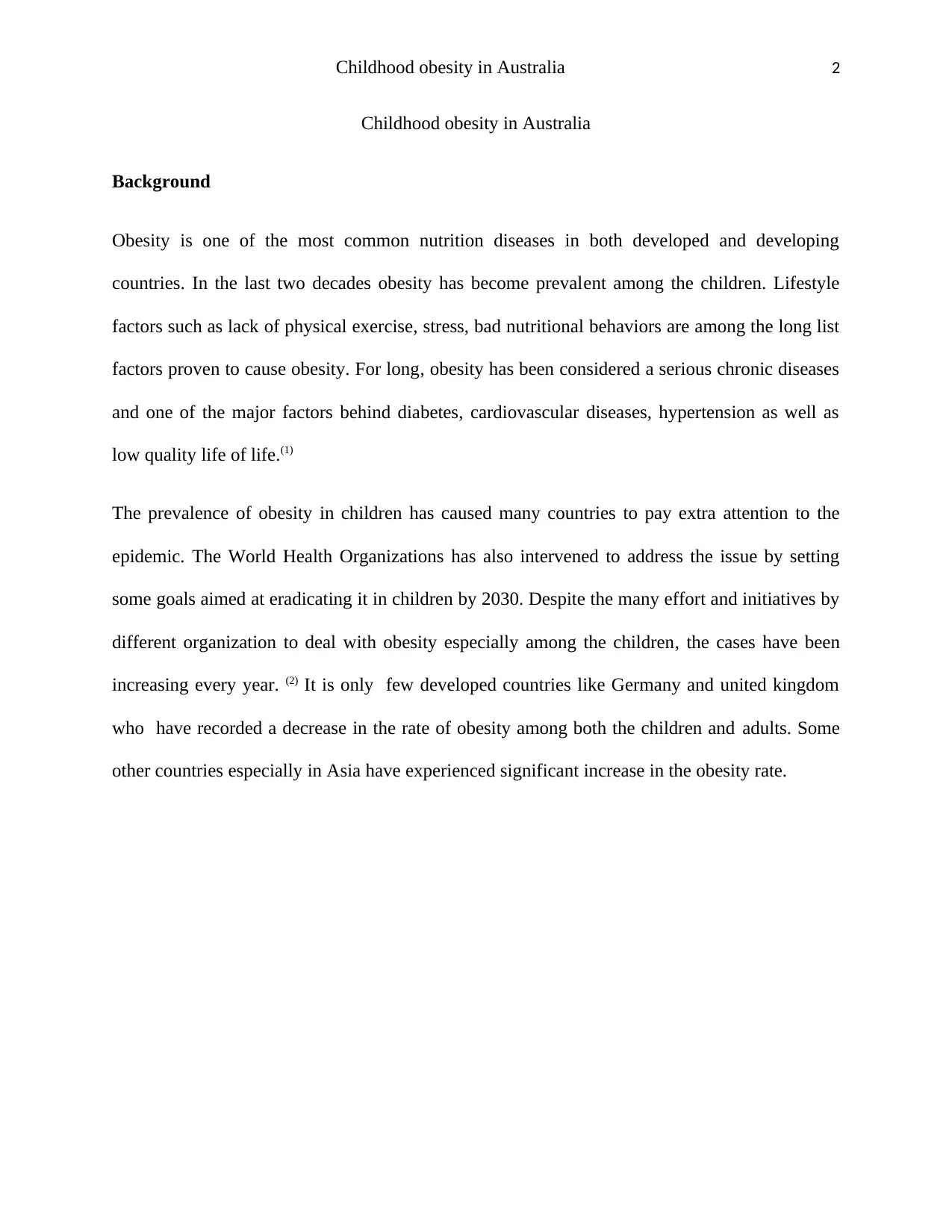
Childhood obesity in Australia 2
Childhood obesity in Australia
Background
Obesity is one of the most common nutrition diseases in both developed and developing
countries. In the last two decades obesity has become prevalent among the children. Lifestyle
factors such as lack of physical exercise, stress, bad nutritional behaviors are among the long list
factors proven to cause obesity. For long, obesity has been considered a serious chronic diseases
and one of the major factors behind diabetes, cardiovascular diseases, hypertension as well as
low quality life of life.(1)
The prevalence of obesity in children has caused many countries to pay extra attention to the
epidemic. The World Health Organizations has also intervened to address the issue by setting
some goals aimed at eradicating it in children by 2030. Despite the many effort and initiatives by
different organization to deal with obesity especially among the children, the cases have been
increasing every year. (2) It is only few developed countries like Germany and united kingdom
who have recorded a decrease in the rate of obesity among both the children and adults. Some
other countries especially in Asia have experienced significant increase in the obesity rate.
Childhood obesity in Australia
Background
Obesity is one of the most common nutrition diseases in both developed and developing
countries. In the last two decades obesity has become prevalent among the children. Lifestyle
factors such as lack of physical exercise, stress, bad nutritional behaviors are among the long list
factors proven to cause obesity. For long, obesity has been considered a serious chronic diseases
and one of the major factors behind diabetes, cardiovascular diseases, hypertension as well as
low quality life of life.(1)
The prevalence of obesity in children has caused many countries to pay extra attention to the
epidemic. The World Health Organizations has also intervened to address the issue by setting
some goals aimed at eradicating it in children by 2030. Despite the many effort and initiatives by
different organization to deal with obesity especially among the children, the cases have been
increasing every year. (2) It is only few developed countries like Germany and united kingdom
who have recorded a decrease in the rate of obesity among both the children and adults. Some
other countries especially in Asia have experienced significant increase in the obesity rate.
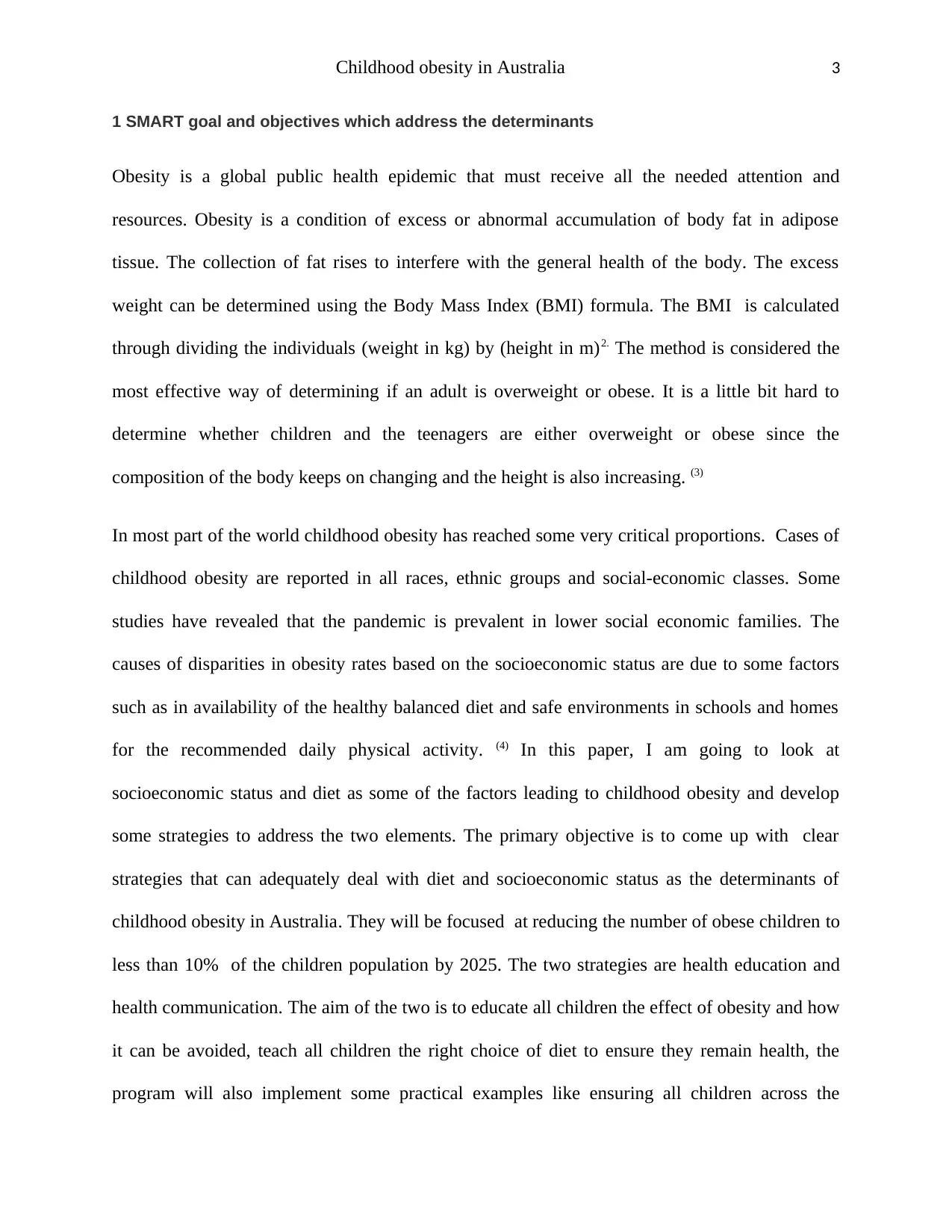
Childhood obesity in Australia 3
1 SMART goal and objectives which address the determinants
Obesity is a global public health epidemic that must receive all the needed attention and
resources. Obesity is a condition of excess or abnormal accumulation of body fat in adipose
tissue. The collection of fat rises to interfere with the general health of the body. The excess
weight can be determined using the Body Mass Index (BMI) formula. The BMI is calculated
through dividing the individuals (weight in kg) by (height in m)2. The method is considered the
most effective way of determining if an adult is overweight or obese. It is a little bit hard to
determine whether children and the teenagers are either overweight or obese since the
composition of the body keeps on changing and the height is also increasing. (3)
In most part of the world childhood obesity has reached some very critical proportions. Cases of
childhood obesity are reported in all races, ethnic groups and social-economic classes. Some
studies have revealed that the pandemic is prevalent in lower social economic families. The
causes of disparities in obesity rates based on the socioeconomic status are due to some factors
such as in availability of the healthy balanced diet and safe environments in schools and homes
for the recommended daily physical activity. (4) In this paper, I am going to look at
socioeconomic status and diet as some of the factors leading to childhood obesity and develop
some strategies to address the two elements. The primary objective is to come up with clear
strategies that can adequately deal with diet and socioeconomic status as the determinants of
childhood obesity in Australia. They will be focused at reducing the number of obese children to
less than 10% of the children population by 2025. The two strategies are health education and
health communication. The aim of the two is to educate all children the effect of obesity and how
it can be avoided, teach all children the right choice of diet to ensure they remain health, the
program will also implement some practical examples like ensuring all children across the
1 SMART goal and objectives which address the determinants
Obesity is a global public health epidemic that must receive all the needed attention and
resources. Obesity is a condition of excess or abnormal accumulation of body fat in adipose
tissue. The collection of fat rises to interfere with the general health of the body. The excess
weight can be determined using the Body Mass Index (BMI) formula. The BMI is calculated
through dividing the individuals (weight in kg) by (height in m)2. The method is considered the
most effective way of determining if an adult is overweight or obese. It is a little bit hard to
determine whether children and the teenagers are either overweight or obese since the
composition of the body keeps on changing and the height is also increasing. (3)
In most part of the world childhood obesity has reached some very critical proportions. Cases of
childhood obesity are reported in all races, ethnic groups and social-economic classes. Some
studies have revealed that the pandemic is prevalent in lower social economic families. The
causes of disparities in obesity rates based on the socioeconomic status are due to some factors
such as in availability of the healthy balanced diet and safe environments in schools and homes
for the recommended daily physical activity. (4) In this paper, I am going to look at
socioeconomic status and diet as some of the factors leading to childhood obesity and develop
some strategies to address the two elements. The primary objective is to come up with clear
strategies that can adequately deal with diet and socioeconomic status as the determinants of
childhood obesity in Australia. They will be focused at reducing the number of obese children to
less than 10% of the children population by 2025. The two strategies are health education and
health communication. The aim of the two is to educate all children the effect of obesity and how
it can be avoided, teach all children the right choice of diet to ensure they remain health, the
program will also implement some practical examples like ensuring all children across the
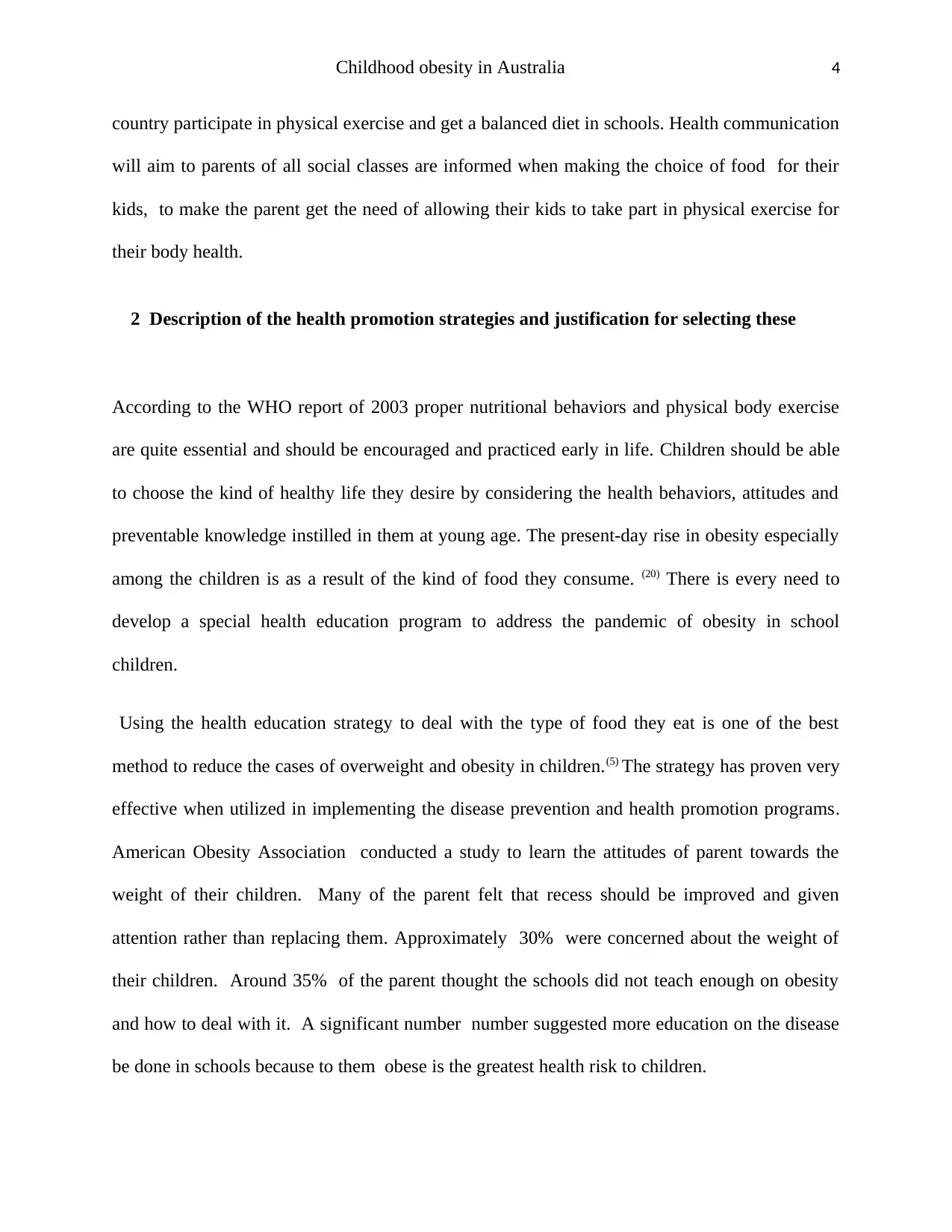
Childhood obesity in Australia 4
country participate in physical exercise and get a balanced diet in schools. Health communication
will aim to parents of all social classes are informed when making the choice of food for their
kids, to make the parent get the need of allowing their kids to take part in physical exercise for
their body health.
2 Description of the health promotion strategies and justification for selecting these
According to the WHO report of 2003 proper nutritional behaviors and physical body exercise
are quite essential and should be encouraged and practiced early in life. Children should be able
to choose the kind of healthy life they desire by considering the health behaviors, attitudes and
preventable knowledge instilled in them at young age. The present-day rise in obesity especially
among the children is as a result of the kind of food they consume. (20) There is every need to
develop a special health education program to address the pandemic of obesity in school
children.
Using the health education strategy to deal with the type of food they eat is one of the best
method to reduce the cases of overweight and obesity in children.(5) The strategy has proven very
effective when utilized in implementing the disease prevention and health promotion programs.
American Obesity Association conducted a study to learn the attitudes of parent towards the
weight of their children. Many of the parent felt that recess should be improved and given
attention rather than replacing them. Approximately 30% were concerned about the weight of
their children. Around 35% of the parent thought the schools did not teach enough on obesity
and how to deal with it. A significant number number suggested more education on the disease
be done in schools because to them obese is the greatest health risk to children.
country participate in physical exercise and get a balanced diet in schools. Health communication
will aim to parents of all social classes are informed when making the choice of food for their
kids, to make the parent get the need of allowing their kids to take part in physical exercise for
their body health.
2 Description of the health promotion strategies and justification for selecting these
According to the WHO report of 2003 proper nutritional behaviors and physical body exercise
are quite essential and should be encouraged and practiced early in life. Children should be able
to choose the kind of healthy life they desire by considering the health behaviors, attitudes and
preventable knowledge instilled in them at young age. The present-day rise in obesity especially
among the children is as a result of the kind of food they consume. (20) There is every need to
develop a special health education program to address the pandemic of obesity in school
children.
Using the health education strategy to deal with the type of food they eat is one of the best
method to reduce the cases of overweight and obesity in children.(5) The strategy has proven very
effective when utilized in implementing the disease prevention and health promotion programs.
American Obesity Association conducted a study to learn the attitudes of parent towards the
weight of their children. Many of the parent felt that recess should be improved and given
attention rather than replacing them. Approximately 30% were concerned about the weight of
their children. Around 35% of the parent thought the schools did not teach enough on obesity
and how to deal with it. A significant number number suggested more education on the disease
be done in schools because to them obese is the greatest health risk to children.
Secure Best Marks with AI Grader
Need help grading? Try our AI Grader for instant feedback on your assignments.
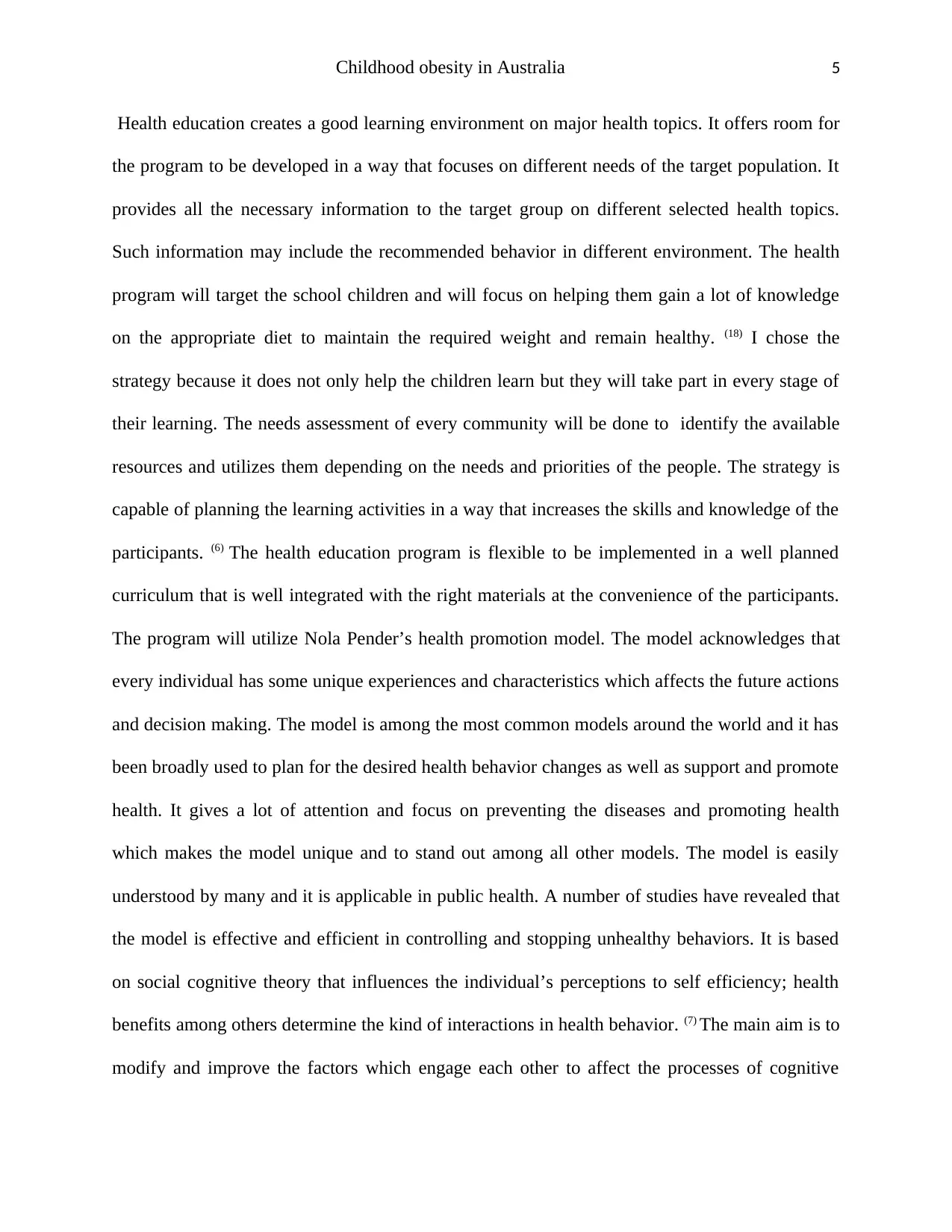
Childhood obesity in Australia 5
Health education creates a good learning environment on major health topics. It offers room for
the program to be developed in a way that focuses on different needs of the target population. It
provides all the necessary information to the target group on different selected health topics.
Such information may include the recommended behavior in different environment. The health
program will target the school children and will focus on helping them gain a lot of knowledge
on the appropriate diet to maintain the required weight and remain healthy. (18) I chose the
strategy because it does not only help the children learn but they will take part in every stage of
their learning. The needs assessment of every community will be done to identify the available
resources and utilizes them depending on the needs and priorities of the people. The strategy is
capable of planning the learning activities in a way that increases the skills and knowledge of the
participants. (6) The health education program is flexible to be implemented in a well planned
curriculum that is well integrated with the right materials at the convenience of the participants.
The program will utilize Nola Pender’s health promotion model. The model acknowledges that
every individual has some unique experiences and characteristics which affects the future actions
and decision making. The model is among the most common models around the world and it has
been broadly used to plan for the desired health behavior changes as well as support and promote
health. It gives a lot of attention and focus on preventing the diseases and promoting health
which makes the model unique and to stand out among all other models. The model is easily
understood by many and it is applicable in public health. A number of studies have revealed that
the model is effective and efficient in controlling and stopping unhealthy behaviors. It is based
on social cognitive theory that influences the individual’s perceptions to self efficiency; health
benefits among others determine the kind of interactions in health behavior. (7) The main aim is to
modify and improve the factors which engage each other to affect the processes of cognitive
Health education creates a good learning environment on major health topics. It offers room for
the program to be developed in a way that focuses on different needs of the target population. It
provides all the necessary information to the target group on different selected health topics.
Such information may include the recommended behavior in different environment. The health
program will target the school children and will focus on helping them gain a lot of knowledge
on the appropriate diet to maintain the required weight and remain healthy. (18) I chose the
strategy because it does not only help the children learn but they will take part in every stage of
their learning. The needs assessment of every community will be done to identify the available
resources and utilizes them depending on the needs and priorities of the people. The strategy is
capable of planning the learning activities in a way that increases the skills and knowledge of the
participants. (6) The health education program is flexible to be implemented in a well planned
curriculum that is well integrated with the right materials at the convenience of the participants.
The program will utilize Nola Pender’s health promotion model. The model acknowledges that
every individual has some unique experiences and characteristics which affects the future actions
and decision making. The model is among the most common models around the world and it has
been broadly used to plan for the desired health behavior changes as well as support and promote
health. It gives a lot of attention and focus on preventing the diseases and promoting health
which makes the model unique and to stand out among all other models. The model is easily
understood by many and it is applicable in public health. A number of studies have revealed that
the model is effective and efficient in controlling and stopping unhealthy behaviors. It is based
on social cognitive theory that influences the individual’s perceptions to self efficiency; health
benefits among others determine the kind of interactions in health behavior. (7) The main aim is to
modify and improve the factors which engage each other to affect the processes of cognitive
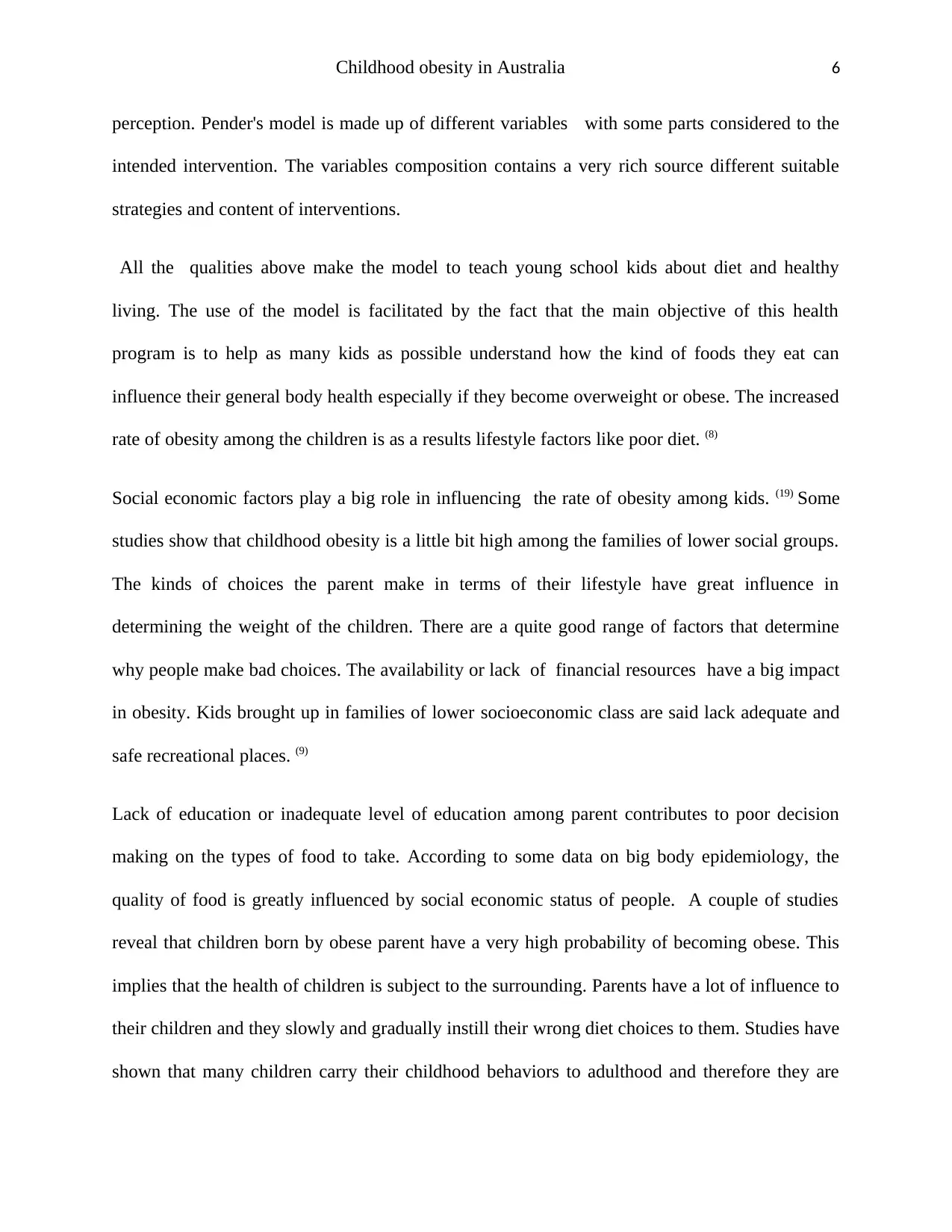
Childhood obesity in Australia 6
perception. Pender's model is made up of different variables with some parts considered to the
intended intervention. The variables composition contains a very rich source different suitable
strategies and content of interventions.
All the qualities above make the model to teach young school kids about diet and healthy
living. The use of the model is facilitated by the fact that the main objective of this health
program is to help as many kids as possible understand how the kind of foods they eat can
influence their general body health especially if they become overweight or obese. The increased
rate of obesity among the children is as a results lifestyle factors like poor diet. (8)
Social economic factors play a big role in influencing the rate of obesity among kids. (19) Some
studies show that childhood obesity is a little bit high among the families of lower social groups.
The kinds of choices the parent make in terms of their lifestyle have great influence in
determining the weight of the children. There are a quite good range of factors that determine
why people make bad choices. The availability or lack of financial resources have a big impact
in obesity. Kids brought up in families of lower socioeconomic class are said lack adequate and
safe recreational places. (9)
Lack of education or inadequate level of education among parent contributes to poor decision
making on the types of food to take. According to some data on big body epidemiology, the
quality of food is greatly influenced by social economic status of people. A couple of studies
reveal that children born by obese parent have a very high probability of becoming obese. This
implies that the health of children is subject to the surrounding. Parents have a lot of influence to
their children and they slowly and gradually instill their wrong diet choices to them. Studies have
shown that many children carry their childhood behaviors to adulthood and therefore they are
perception. Pender's model is made up of different variables with some parts considered to the
intended intervention. The variables composition contains a very rich source different suitable
strategies and content of interventions.
All the qualities above make the model to teach young school kids about diet and healthy
living. The use of the model is facilitated by the fact that the main objective of this health
program is to help as many kids as possible understand how the kind of foods they eat can
influence their general body health especially if they become overweight or obese. The increased
rate of obesity among the children is as a results lifestyle factors like poor diet. (8)
Social economic factors play a big role in influencing the rate of obesity among kids. (19) Some
studies show that childhood obesity is a little bit high among the families of lower social groups.
The kinds of choices the parent make in terms of their lifestyle have great influence in
determining the weight of the children. There are a quite good range of factors that determine
why people make bad choices. The availability or lack of financial resources have a big impact
in obesity. Kids brought up in families of lower socioeconomic class are said lack adequate and
safe recreational places. (9)
Lack of education or inadequate level of education among parent contributes to poor decision
making on the types of food to take. According to some data on big body epidemiology, the
quality of food is greatly influenced by social economic status of people. A couple of studies
reveal that children born by obese parent have a very high probability of becoming obese. This
implies that the health of children is subject to the surrounding. Parents have a lot of influence to
their children and they slowly and gradually instill their wrong diet choices to them. Studies have
shown that many children carry their childhood behaviors to adulthood and therefore they are
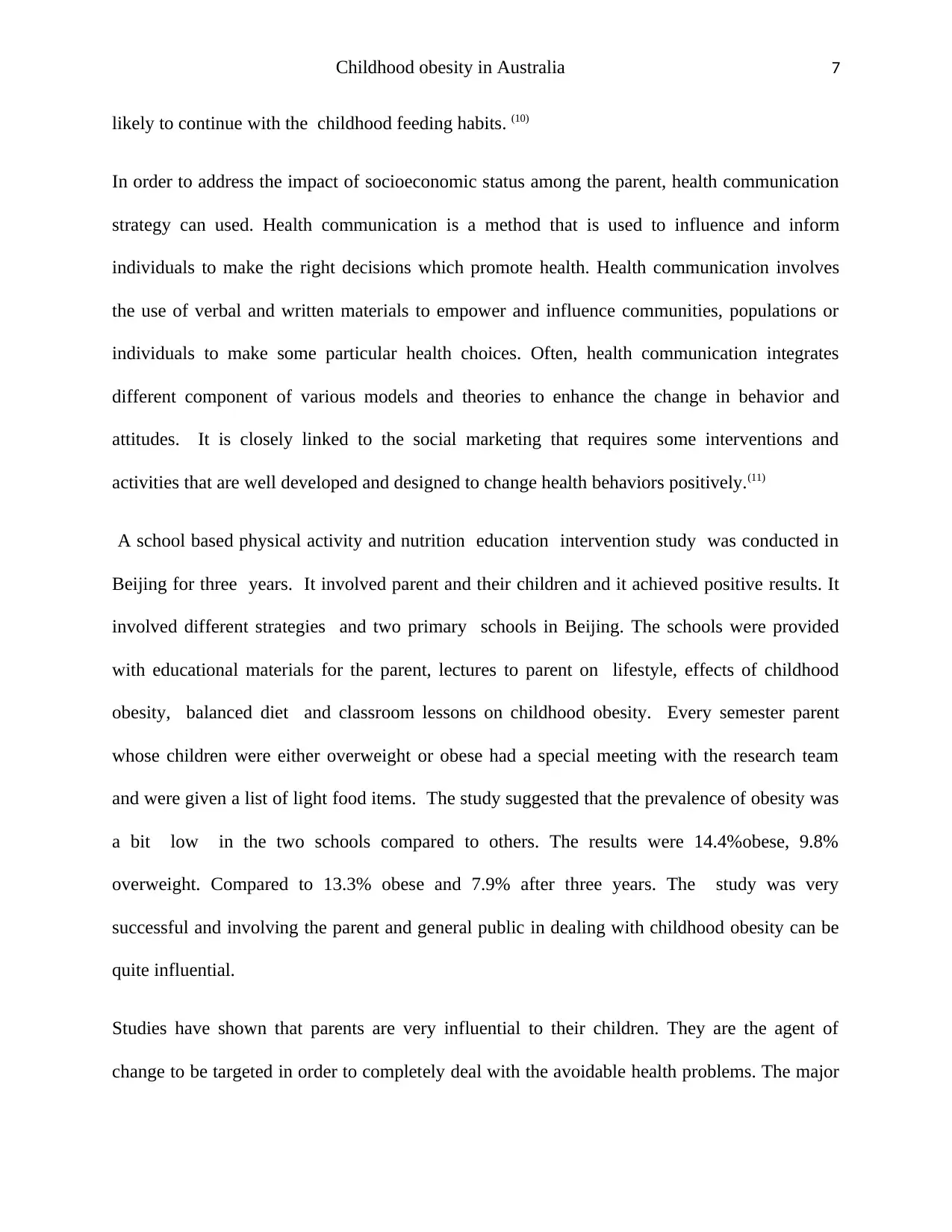
Childhood obesity in Australia 7
likely to continue with the childhood feeding habits. (10)
In order to address the impact of socioeconomic status among the parent, health communication
strategy can used. Health communication is a method that is used to influence and inform
individuals to make the right decisions which promote health. Health communication involves
the use of verbal and written materials to empower and influence communities, populations or
individuals to make some particular health choices. Often, health communication integrates
different component of various models and theories to enhance the change in behavior and
attitudes. It is closely linked to the social marketing that requires some interventions and
activities that are well developed and designed to change health behaviors positively.(11)
A school based physical activity and nutrition education intervention study was conducted in
Beijing for three years. It involved parent and their children and it achieved positive results. It
involved different strategies and two primary schools in Beijing. The schools were provided
with educational materials for the parent, lectures to parent on lifestyle, effects of childhood
obesity, balanced diet and classroom lessons on childhood obesity. Every semester parent
whose children were either overweight or obese had a special meeting with the research team
and were given a list of light food items. The study suggested that the prevalence of obesity was
a bit low in the two schools compared to others. The results were 14.4%obese, 9.8%
overweight. Compared to 13.3% obese and 7.9% after three years. The study was very
successful and involving the parent and general public in dealing with childhood obesity can be
quite influential.
Studies have shown that parents are very influential to their children. They are the agent of
change to be targeted in order to completely deal with the avoidable health problems. The major
likely to continue with the childhood feeding habits. (10)
In order to address the impact of socioeconomic status among the parent, health communication
strategy can used. Health communication is a method that is used to influence and inform
individuals to make the right decisions which promote health. Health communication involves
the use of verbal and written materials to empower and influence communities, populations or
individuals to make some particular health choices. Often, health communication integrates
different component of various models and theories to enhance the change in behavior and
attitudes. It is closely linked to the social marketing that requires some interventions and
activities that are well developed and designed to change health behaviors positively.(11)
A school based physical activity and nutrition education intervention study was conducted in
Beijing for three years. It involved parent and their children and it achieved positive results. It
involved different strategies and two primary schools in Beijing. The schools were provided
with educational materials for the parent, lectures to parent on lifestyle, effects of childhood
obesity, balanced diet and classroom lessons on childhood obesity. Every semester parent
whose children were either overweight or obese had a special meeting with the research team
and were given a list of light food items. The study suggested that the prevalence of obesity was
a bit low in the two schools compared to others. The results were 14.4%obese, 9.8%
overweight. Compared to 13.3% obese and 7.9% after three years. The study was very
successful and involving the parent and general public in dealing with childhood obesity can be
quite influential.
Studies have shown that parents are very influential to their children. They are the agent of
change to be targeted in order to completely deal with the avoidable health problems. The major
Paraphrase This Document
Need a fresh take? Get an instant paraphrase of this document with our AI Paraphraser

Childhood obesity in Australia 8
focus will identify the most reliable and effective ways to reach the parent and communicate
about healthy eating and physical exercise especially those who are affected by either overweight
or obesity. It is important to use a variety of methods to reach the parent because they depend on
different sources of information each according to their level education, economic status or
social class the society. The communication will major on the health of children and will
therefore involve doctors and other health care workers to deliver the main message to the public
in a way that accommodates individuals with little or no education in the society. (12) The
communication will be done using the social media, televisions, radios written materials and
verbally in public gatherings. Some research established that friends are also influential source
of information especially in social events. Encouraging people to share the knowledge of obesity
and how it can be prevented will play a big role ensuring the information is available to more
people. Churches, working places schools and mothers groups are very important in health
communication especially among the parent. (13)
In health communication strategy the health belief model will be the most appropriate and
suitable. It looks at how people perceive and reacts to certain diseases threats and disadvantages
of some behaviors and beliefs. According to the model the advantages of an action must be more
than the barriers that people perceive.
3 Indication of different personnel and partner organizations who would be involved in
implementing the strategies
In order to fully implement the health education and health communication as the appropriate
focus will identify the most reliable and effective ways to reach the parent and communicate
about healthy eating and physical exercise especially those who are affected by either overweight
or obesity. It is important to use a variety of methods to reach the parent because they depend on
different sources of information each according to their level education, economic status or
social class the society. The communication will major on the health of children and will
therefore involve doctors and other health care workers to deliver the main message to the public
in a way that accommodates individuals with little or no education in the society. (12) The
communication will be done using the social media, televisions, radios written materials and
verbally in public gatherings. Some research established that friends are also influential source
of information especially in social events. Encouraging people to share the knowledge of obesity
and how it can be prevented will play a big role ensuring the information is available to more
people. Churches, working places schools and mothers groups are very important in health
communication especially among the parent. (13)
In health communication strategy the health belief model will be the most appropriate and
suitable. It looks at how people perceive and reacts to certain diseases threats and disadvantages
of some behaviors and beliefs. According to the model the advantages of an action must be more
than the barriers that people perceive.
3 Indication of different personnel and partner organizations who would be involved in
implementing the strategies
In order to fully implement the health education and health communication as the appropriate
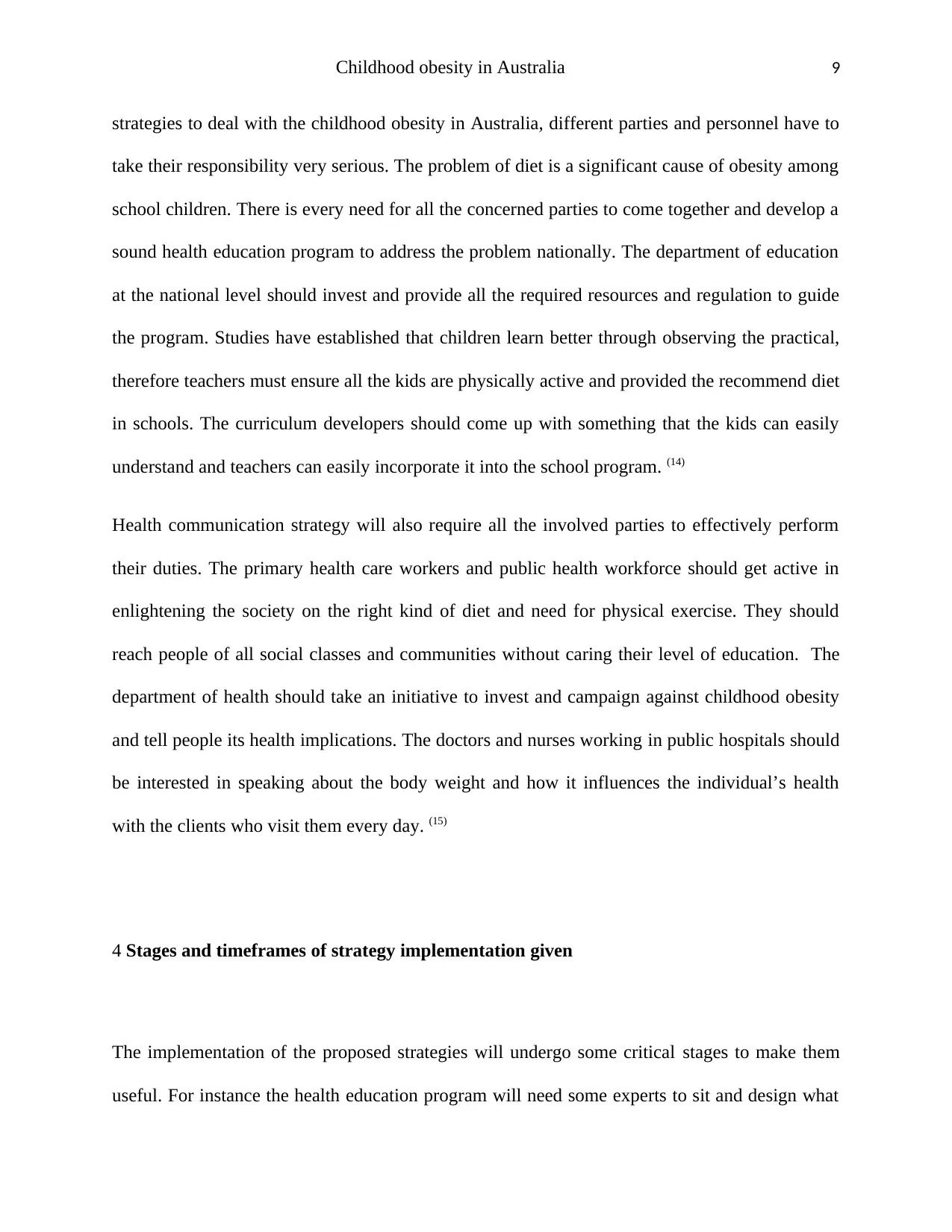
Childhood obesity in Australia 9
strategies to deal with the childhood obesity in Australia, different parties and personnel have to
take their responsibility very serious. The problem of diet is a significant cause of obesity among
school children. There is every need for all the concerned parties to come together and develop a
sound health education program to address the problem nationally. The department of education
at the national level should invest and provide all the required resources and regulation to guide
the program. Studies have established that children learn better through observing the practical,
therefore teachers must ensure all the kids are physically active and provided the recommend diet
in schools. The curriculum developers should come up with something that the kids can easily
understand and teachers can easily incorporate it into the school program. (14)
Health communication strategy will also require all the involved parties to effectively perform
their duties. The primary health care workers and public health workforce should get active in
enlightening the society on the right kind of diet and need for physical exercise. They should
reach people of all social classes and communities without caring their level of education. The
department of health should take an initiative to invest and campaign against childhood obesity
and tell people its health implications. The doctors and nurses working in public hospitals should
be interested in speaking about the body weight and how it influences the individual’s health
with the clients who visit them every day. (15)
4 Stages and timeframes of strategy implementation given
The implementation of the proposed strategies will undergo some critical stages to make them
useful. For instance the health education program will need some experts to sit and design what
strategies to deal with the childhood obesity in Australia, different parties and personnel have to
take their responsibility very serious. The problem of diet is a significant cause of obesity among
school children. There is every need for all the concerned parties to come together and develop a
sound health education program to address the problem nationally. The department of education
at the national level should invest and provide all the required resources and regulation to guide
the program. Studies have established that children learn better through observing the practical,
therefore teachers must ensure all the kids are physically active and provided the recommend diet
in schools. The curriculum developers should come up with something that the kids can easily
understand and teachers can easily incorporate it into the school program. (14)
Health communication strategy will also require all the involved parties to effectively perform
their duties. The primary health care workers and public health workforce should get active in
enlightening the society on the right kind of diet and need for physical exercise. They should
reach people of all social classes and communities without caring their level of education. The
department of health should take an initiative to invest and campaign against childhood obesity
and tell people its health implications. The doctors and nurses working in public hospitals should
be interested in speaking about the body weight and how it influences the individual’s health
with the clients who visit them every day. (15)
4 Stages and timeframes of strategy implementation given
The implementation of the proposed strategies will undergo some critical stages to make them
useful. For instance the health education program will need some experts to sit and design what
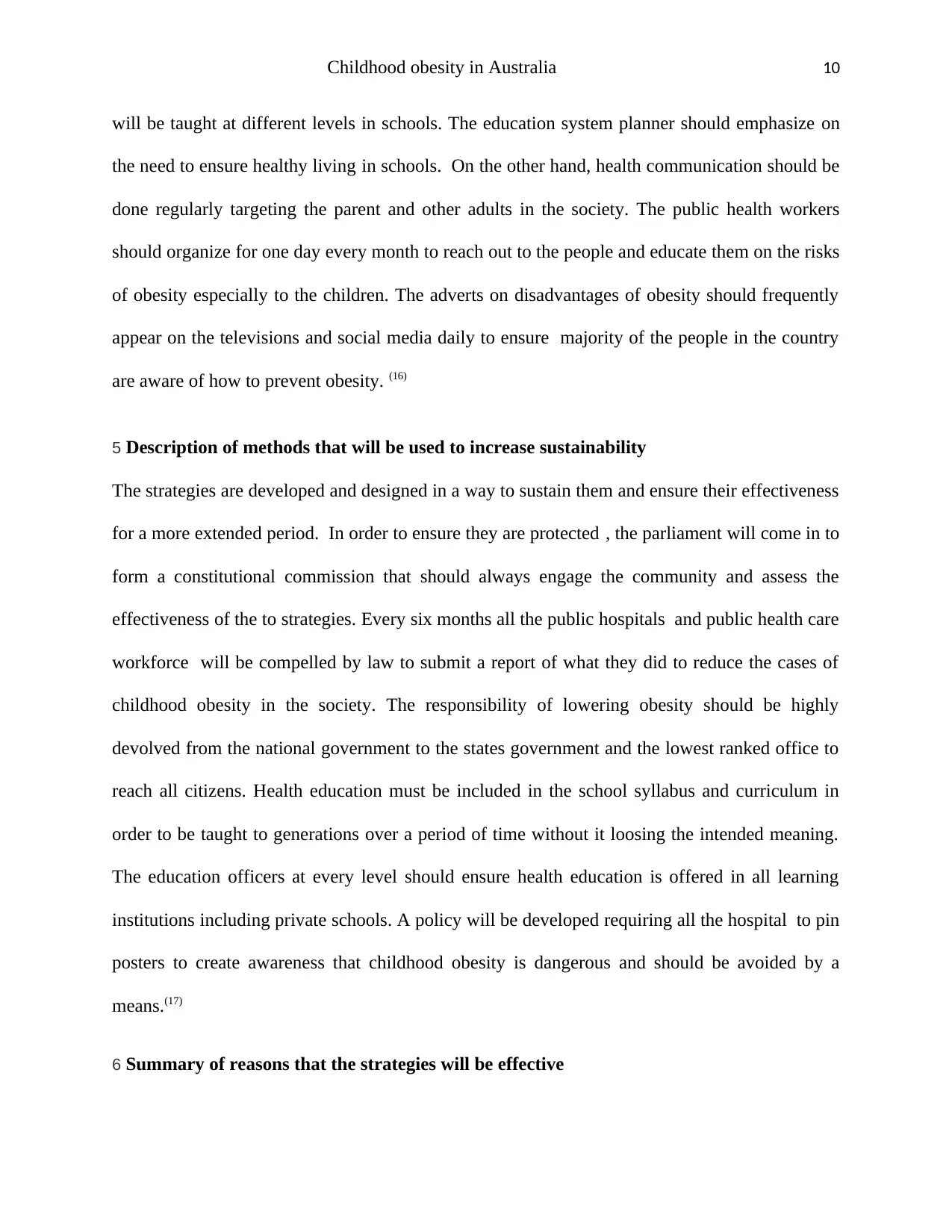
Childhood obesity in Australia 10
will be taught at different levels in schools. The education system planner should emphasize on
the need to ensure healthy living in schools. On the other hand, health communication should be
done regularly targeting the parent and other adults in the society. The public health workers
should organize for one day every month to reach out to the people and educate them on the risks
of obesity especially to the children. The adverts on disadvantages of obesity should frequently
appear on the televisions and social media daily to ensure majority of the people in the country
are aware of how to prevent obesity. (16)
5 Description of methods that will be used to increase sustainability
The strategies are developed and designed in a way to sustain them and ensure their effectiveness
for a more extended period. In order to ensure they are protected , the parliament will come in to
form a constitutional commission that should always engage the community and assess the
effectiveness of the to strategies. Every six months all the public hospitals and public health care
workforce will be compelled by law to submit a report of what they did to reduce the cases of
childhood obesity in the society. The responsibility of lowering obesity should be highly
devolved from the national government to the states government and the lowest ranked office to
reach all citizens. Health education must be included in the school syllabus and curriculum in
order to be taught to generations over a period of time without it loosing the intended meaning.
The education officers at every level should ensure health education is offered in all learning
institutions including private schools. A policy will be developed requiring all the hospital to pin
posters to create awareness that childhood obesity is dangerous and should be avoided by a
means.(17)
6 Summary of reasons that the strategies will be effective
will be taught at different levels in schools. The education system planner should emphasize on
the need to ensure healthy living in schools. On the other hand, health communication should be
done regularly targeting the parent and other adults in the society. The public health workers
should organize for one day every month to reach out to the people and educate them on the risks
of obesity especially to the children. The adverts on disadvantages of obesity should frequently
appear on the televisions and social media daily to ensure majority of the people in the country
are aware of how to prevent obesity. (16)
5 Description of methods that will be used to increase sustainability
The strategies are developed and designed in a way to sustain them and ensure their effectiveness
for a more extended period. In order to ensure they are protected , the parliament will come in to
form a constitutional commission that should always engage the community and assess the
effectiveness of the to strategies. Every six months all the public hospitals and public health care
workforce will be compelled by law to submit a report of what they did to reduce the cases of
childhood obesity in the society. The responsibility of lowering obesity should be highly
devolved from the national government to the states government and the lowest ranked office to
reach all citizens. Health education must be included in the school syllabus and curriculum in
order to be taught to generations over a period of time without it loosing the intended meaning.
The education officers at every level should ensure health education is offered in all learning
institutions including private schools. A policy will be developed requiring all the hospital to pin
posters to create awareness that childhood obesity is dangerous and should be avoided by a
means.(17)
6 Summary of reasons that the strategies will be effective
Secure Best Marks with AI Grader
Need help grading? Try our AI Grader for instant feedback on your assignments.
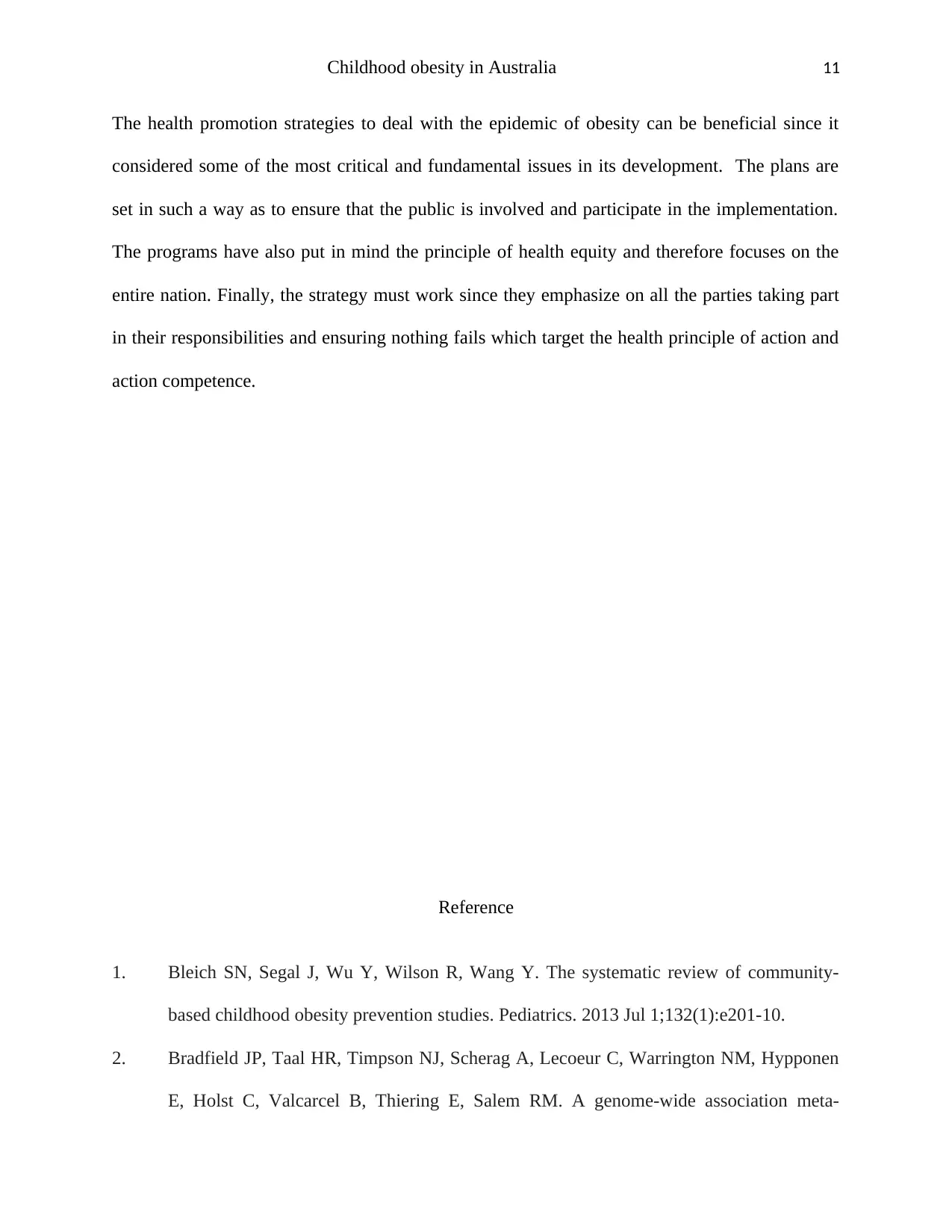
Childhood obesity in Australia 11
The health promotion strategies to deal with the epidemic of obesity can be beneficial since it
considered some of the most critical and fundamental issues in its development. The plans are
set in such a way as to ensure that the public is involved and participate in the implementation.
The programs have also put in mind the principle of health equity and therefore focuses on the
entire nation. Finally, the strategy must work since they emphasize on all the parties taking part
in their responsibilities and ensuring nothing fails which target the health principle of action and
action competence.
Reference
1. Bleich SN, Segal J, Wu Y, Wilson R, Wang Y. The systematic review of community-
based childhood obesity prevention studies. Pediatrics. 2013 Jul 1;132(1):e201-10.
2. Bradfield JP, Taal HR, Timpson NJ, Scherag A, Lecoeur C, Warrington NM, Hypponen
E, Holst C, Valcarcel B, Thiering E, Salem RM. A genome-wide association meta-
The health promotion strategies to deal with the epidemic of obesity can be beneficial since it
considered some of the most critical and fundamental issues in its development. The plans are
set in such a way as to ensure that the public is involved and participate in the implementation.
The programs have also put in mind the principle of health equity and therefore focuses on the
entire nation. Finally, the strategy must work since they emphasize on all the parties taking part
in their responsibilities and ensuring nothing fails which target the health principle of action and
action competence.
Reference
1. Bleich SN, Segal J, Wu Y, Wilson R, Wang Y. The systematic review of community-
based childhood obesity prevention studies. Pediatrics. 2013 Jul 1;132(1):e201-10.
2. Bradfield JP, Taal HR, Timpson NJ, Scherag A, Lecoeur C, Warrington NM, Hypponen
E, Holst C, Valcarcel B, Thiering E, Salem RM. A genome-wide association meta-
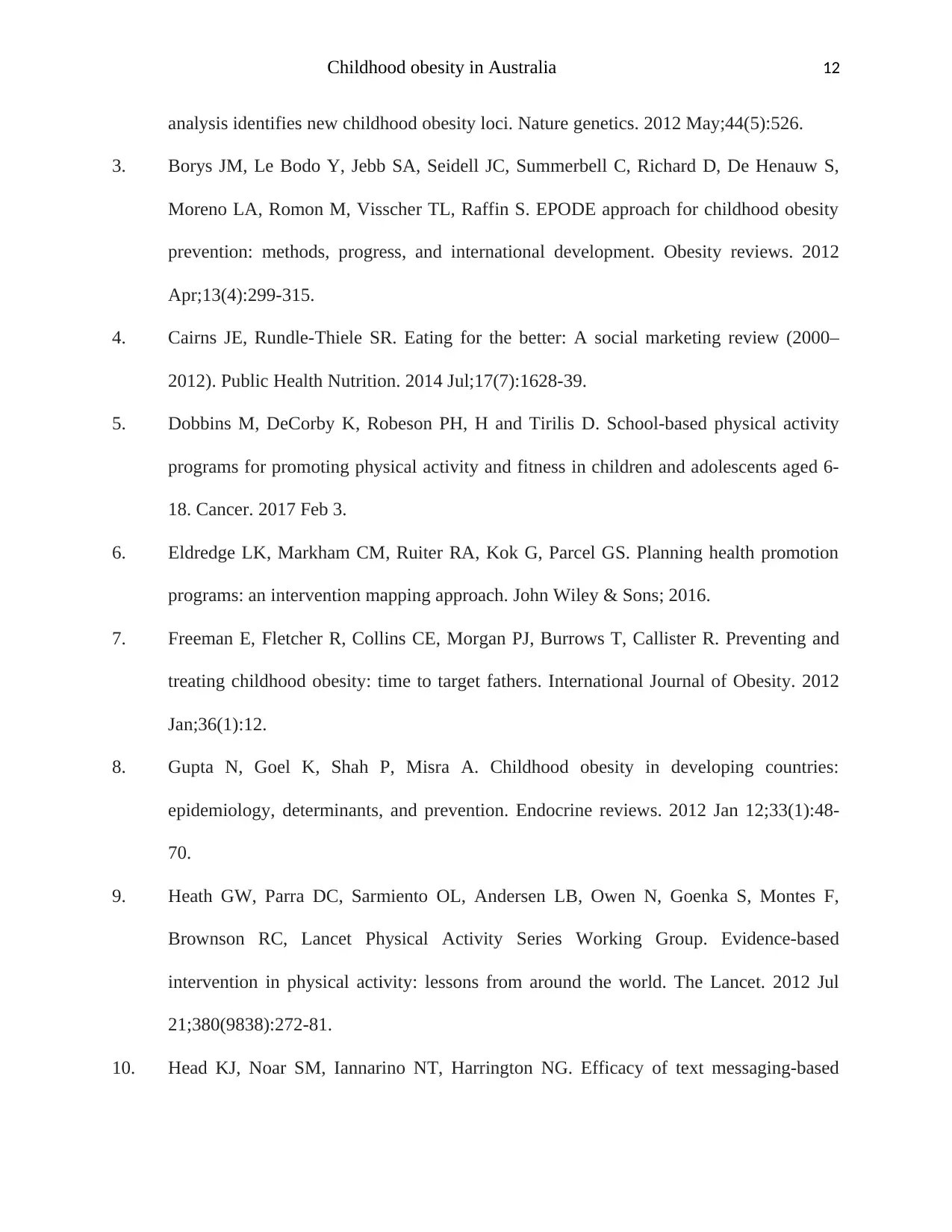
Childhood obesity in Australia 12
analysis identifies new childhood obesity loci. Nature genetics. 2012 May;44(5):526.
3. Borys JM, Le Bodo Y, Jebb SA, Seidell JC, Summerbell C, Richard D, De Henauw S,
Moreno LA, Romon M, Visscher TL, Raffin S. EPODE approach for childhood obesity
prevention: methods, progress, and international development. Obesity reviews. 2012
Apr;13(4):299-315.
4. Cairns JE, Rundle-Thiele SR. Eating for the better: A social marketing review (2000–
2012). Public Health Nutrition. 2014 Jul;17(7):1628-39.
5. Dobbins M, DeCorby K, Robeson PH, H and Tirilis D. School-based physical activity
programs for promoting physical activity and fitness in children and adolescents aged 6-
18. Cancer. 2017 Feb 3.
6. Eldredge LK, Markham CM, Ruiter RA, Kok G, Parcel GS. Planning health promotion
programs: an intervention mapping approach. John Wiley & Sons; 2016.
7. Freeman E, Fletcher R, Collins CE, Morgan PJ, Burrows T, Callister R. Preventing and
treating childhood obesity: time to target fathers. International Journal of Obesity. 2012
Jan;36(1):12.
8. Gupta N, Goel K, Shah P, Misra A. Childhood obesity in developing countries:
epidemiology, determinants, and prevention. Endocrine reviews. 2012 Jan 12;33(1):48-
70.
9. Heath GW, Parra DC, Sarmiento OL, Andersen LB, Owen N, Goenka S, Montes F,
Brownson RC, Lancet Physical Activity Series Working Group. Evidence-based
intervention in physical activity: lessons from around the world. The Lancet. 2012 Jul
21;380(9838):272-81.
10. Head KJ, Noar SM, Iannarino NT, Harrington NG. Efficacy of text messaging-based
analysis identifies new childhood obesity loci. Nature genetics. 2012 May;44(5):526.
3. Borys JM, Le Bodo Y, Jebb SA, Seidell JC, Summerbell C, Richard D, De Henauw S,
Moreno LA, Romon M, Visscher TL, Raffin S. EPODE approach for childhood obesity
prevention: methods, progress, and international development. Obesity reviews. 2012
Apr;13(4):299-315.
4. Cairns JE, Rundle-Thiele SR. Eating for the better: A social marketing review (2000–
2012). Public Health Nutrition. 2014 Jul;17(7):1628-39.
5. Dobbins M, DeCorby K, Robeson PH, H and Tirilis D. School-based physical activity
programs for promoting physical activity and fitness in children and adolescents aged 6-
18. Cancer. 2017 Feb 3.
6. Eldredge LK, Markham CM, Ruiter RA, Kok G, Parcel GS. Planning health promotion
programs: an intervention mapping approach. John Wiley & Sons; 2016.
7. Freeman E, Fletcher R, Collins CE, Morgan PJ, Burrows T, Callister R. Preventing and
treating childhood obesity: time to target fathers. International Journal of Obesity. 2012
Jan;36(1):12.
8. Gupta N, Goel K, Shah P, Misra A. Childhood obesity in developing countries:
epidemiology, determinants, and prevention. Endocrine reviews. 2012 Jan 12;33(1):48-
70.
9. Heath GW, Parra DC, Sarmiento OL, Andersen LB, Owen N, Goenka S, Montes F,
Brownson RC, Lancet Physical Activity Series Working Group. Evidence-based
intervention in physical activity: lessons from around the world. The Lancet. 2012 Jul
21;380(9838):272-81.
10. Head KJ, Noar SM, Iannarino NT, Harrington NG. Efficacy of text messaging-based
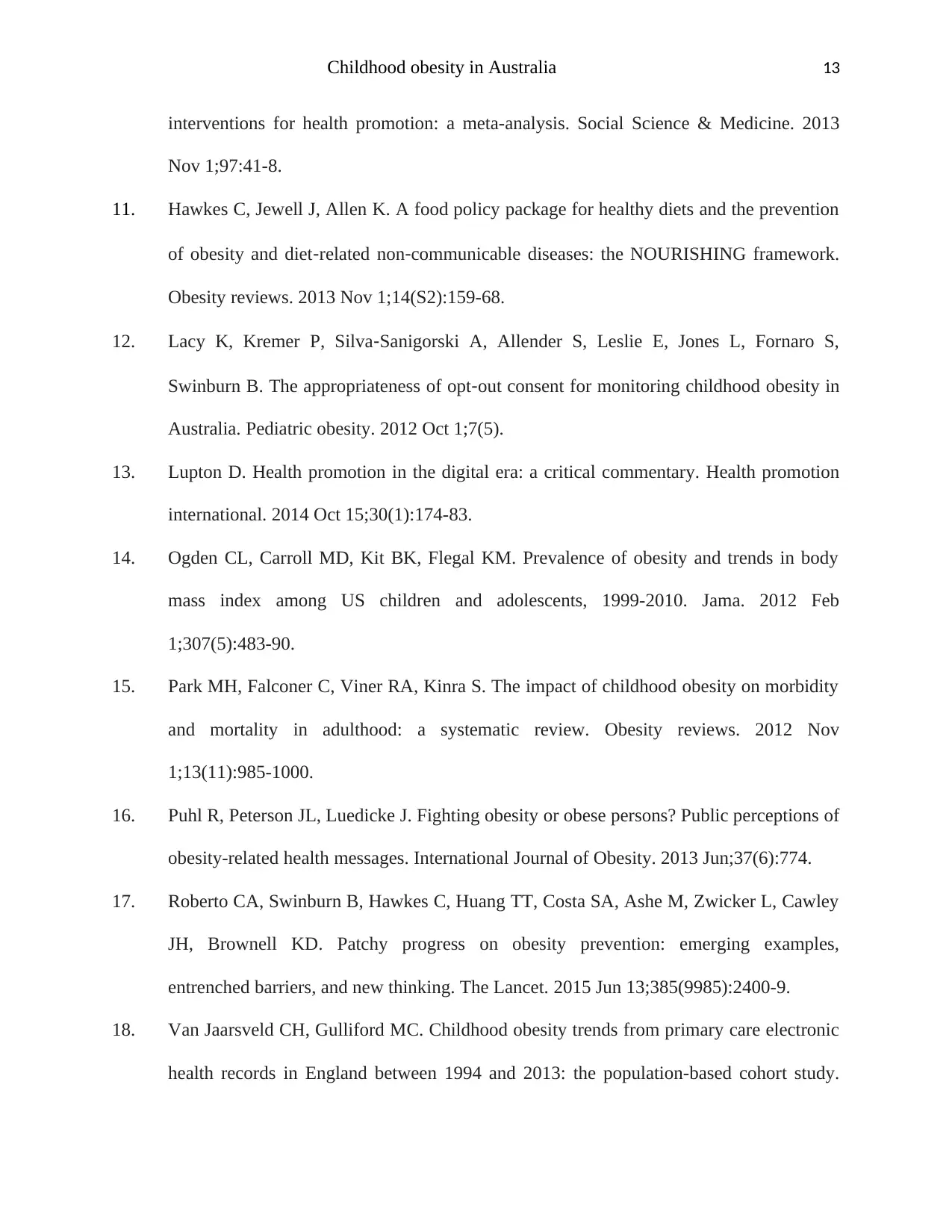
Childhood obesity in Australia 13
interventions for health promotion: a meta-analysis. Social Science & Medicine. 2013
Nov 1;97:41-8.
11. Hawkes C, Jewell J, Allen K. A food policy package for healthy diets and the prevention
of obesity and diet‐related non‐communicable diseases: the NOURISHING framework.
Obesity reviews. 2013 Nov 1;14(S2):159-68.
12. Lacy K, Kremer P, Silva‐Sanigorski A, Allender S, Leslie E, Jones L, Fornaro S,
Swinburn B. The appropriateness of opt‐out consent for monitoring childhood obesity in
Australia. Pediatric obesity. 2012 Oct 1;7(5).
13. Lupton D. Health promotion in the digital era: a critical commentary. Health promotion
international. 2014 Oct 15;30(1):174-83.
14. Ogden CL, Carroll MD, Kit BK, Flegal KM. Prevalence of obesity and trends in body
mass index among US children and adolescents, 1999-2010. Jama. 2012 Feb
1;307(5):483-90.
15. Park MH, Falconer C, Viner RA, Kinra S. The impact of childhood obesity on morbidity
and mortality in adulthood: a systematic review. Obesity reviews. 2012 Nov
1;13(11):985-1000.
16. Puhl R, Peterson JL, Luedicke J. Fighting obesity or obese persons? Public perceptions of
obesity-related health messages. International Journal of Obesity. 2013 Jun;37(6):774.
17. Roberto CA, Swinburn B, Hawkes C, Huang TT, Costa SA, Ashe M, Zwicker L, Cawley
JH, Brownell KD. Patchy progress on obesity prevention: emerging examples,
entrenched barriers, and new thinking. The Lancet. 2015 Jun 13;385(9985):2400-9.
18. Van Jaarsveld CH, Gulliford MC. Childhood obesity trends from primary care electronic
health records in England between 1994 and 2013: the population-based cohort study.
interventions for health promotion: a meta-analysis. Social Science & Medicine. 2013
Nov 1;97:41-8.
11. Hawkes C, Jewell J, Allen K. A food policy package for healthy diets and the prevention
of obesity and diet‐related non‐communicable diseases: the NOURISHING framework.
Obesity reviews. 2013 Nov 1;14(S2):159-68.
12. Lacy K, Kremer P, Silva‐Sanigorski A, Allender S, Leslie E, Jones L, Fornaro S,
Swinburn B. The appropriateness of opt‐out consent for monitoring childhood obesity in
Australia. Pediatric obesity. 2012 Oct 1;7(5).
13. Lupton D. Health promotion in the digital era: a critical commentary. Health promotion
international. 2014 Oct 15;30(1):174-83.
14. Ogden CL, Carroll MD, Kit BK, Flegal KM. Prevalence of obesity and trends in body
mass index among US children and adolescents, 1999-2010. Jama. 2012 Feb
1;307(5):483-90.
15. Park MH, Falconer C, Viner RA, Kinra S. The impact of childhood obesity on morbidity
and mortality in adulthood: a systematic review. Obesity reviews. 2012 Nov
1;13(11):985-1000.
16. Puhl R, Peterson JL, Luedicke J. Fighting obesity or obese persons? Public perceptions of
obesity-related health messages. International Journal of Obesity. 2013 Jun;37(6):774.
17. Roberto CA, Swinburn B, Hawkes C, Huang TT, Costa SA, Ashe M, Zwicker L, Cawley
JH, Brownell KD. Patchy progress on obesity prevention: emerging examples,
entrenched barriers, and new thinking. The Lancet. 2015 Jun 13;385(9985):2400-9.
18. Van Jaarsveld CH, Gulliford MC. Childhood obesity trends from primary care electronic
health records in England between 1994 and 2013: the population-based cohort study.
Paraphrase This Document
Need a fresh take? Get an instant paraphrase of this document with our AI Paraphraser
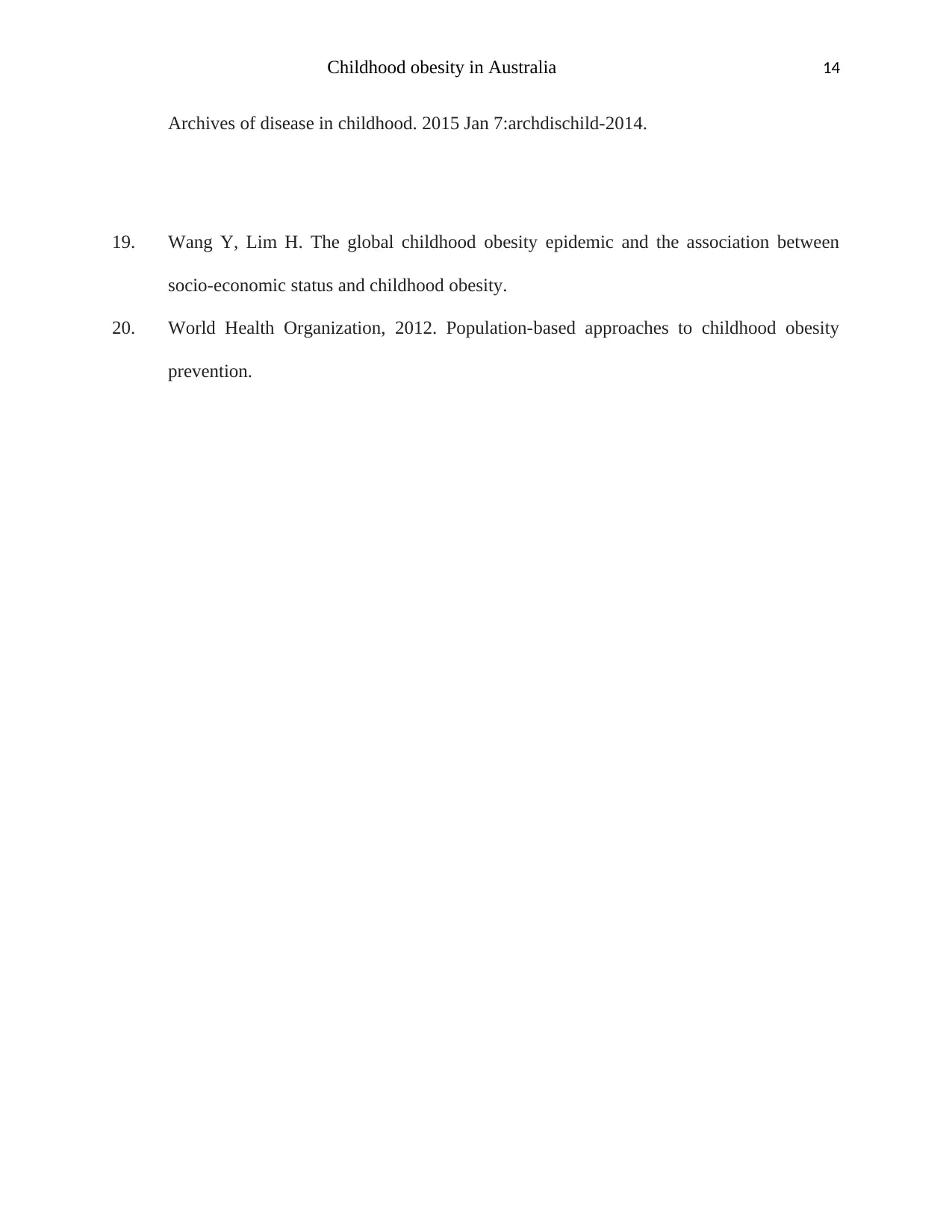
Childhood obesity in Australia 14
Archives of disease in childhood. 2015 Jan 7:archdischild-2014.
19. Wang Y, Lim H. The global childhood obesity epidemic and the association between
socio-economic status and childhood obesity.
20. World Health Organization, 2012. Population-based approaches to childhood obesity
prevention.
Archives of disease in childhood. 2015 Jan 7:archdischild-2014.
19. Wang Y, Lim H. The global childhood obesity epidemic and the association between
socio-economic status and childhood obesity.
20. World Health Organization, 2012. Population-based approaches to childhood obesity
prevention.
1 out of 14
Related Documents
Your All-in-One AI-Powered Toolkit for Academic Success.
+13062052269
info@desklib.com
Available 24*7 on WhatsApp / Email
![[object Object]](/_next/static/media/star-bottom.7253800d.svg)
Unlock your academic potential
© 2024 | Zucol Services PVT LTD | All rights reserved.





